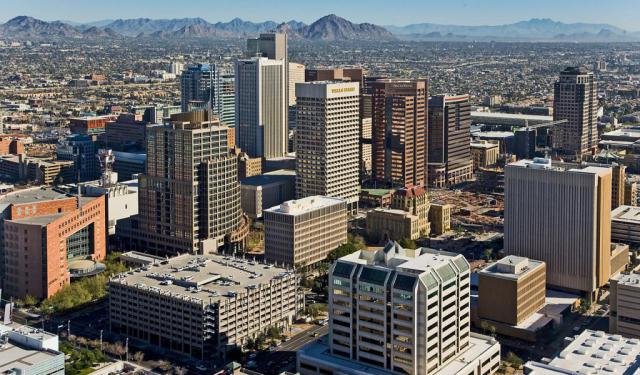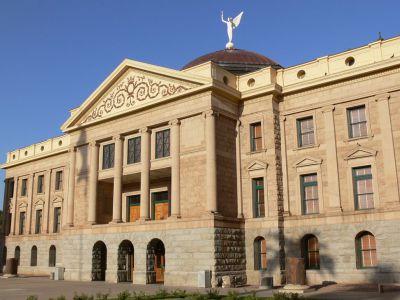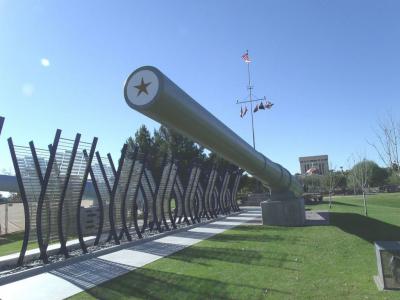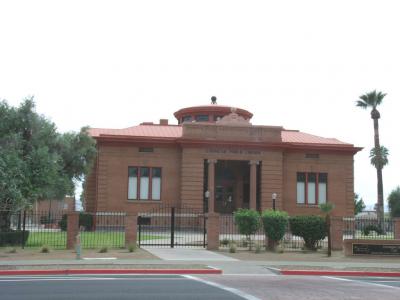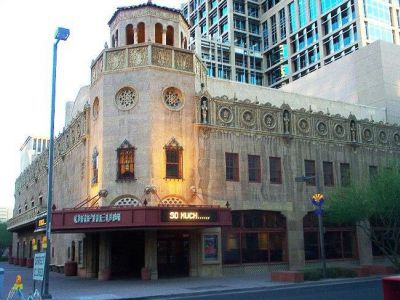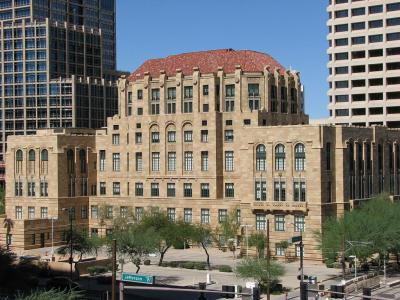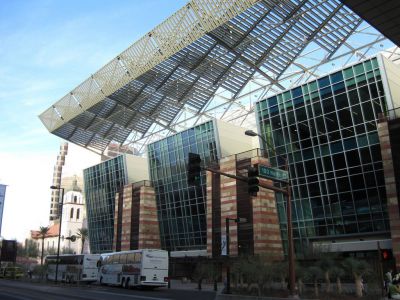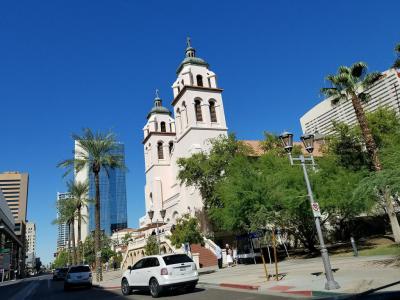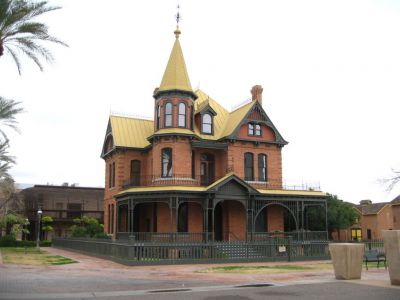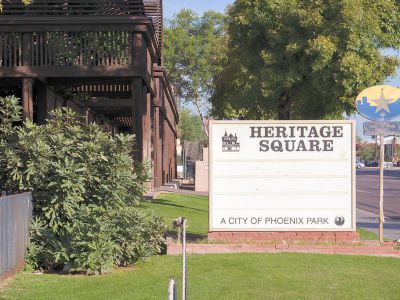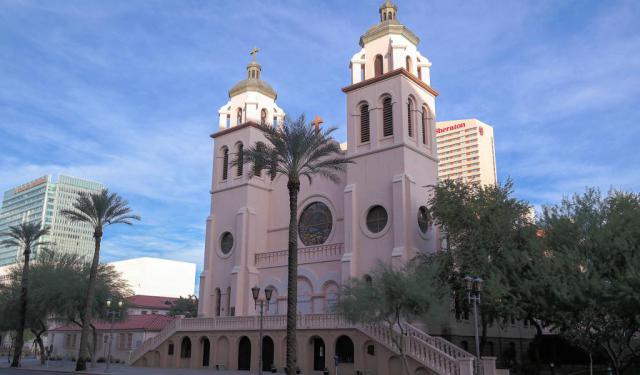Phoenix Introduction Walking Tour (Self Guided), Phoenix
Phoenix is the largest city in Arizona and the central city in a larger metropolitan area known as the Valley of the Sun. The city was first settled as an agricultural community where the Salt and Gila Rivers met. An intricate canal system keeps this hot corner of the Sonoran Desert fertile. In the early days, the city's economy was based on the "Five Cs"-citrus, cotton, copper, cattle, and climate. In the late 20th century, tech companies began moving to Phoenix.
Native American tribes have occupied the area for more than 2,000 years. The first settlers were the Hohokam people, and they were the first ones to begin irrigating the arid desert for farmland. The Hohokam eventually left, and the area was settled by several tribes after that, including the Akimel O'odham, Tohono O'odham, and Maricopa tribes. An excellent place to learn more about the tribes and their histories is the Heard Museum in Phoenix, specializing in Native American art and culture.
Phoenix got its start when a Confederate veteran of the Civil War, Jack Swilling, came to the area. He noticed the Hohokam's abandoned canals and decided that the area could once again be used for farming. The name was used to describe a city born from the ashes of a previous settlement. The town was formed in 1868 and officially incorporated in 1881.
Phoenix has always been a popular destination, thanks to the climate and culture. Today, it's America's second-fastest-growing city. The Desert Botanical Garden will show you the local environment and provide spectacular views of the desert. The State Capitol Museum, Wesley Bolin Memorial Plaza, and Heritage Square will provide insight into the city and state's history. Take this self-guided walking tour to see what all the excitement is about in Phoenix.
Native American tribes have occupied the area for more than 2,000 years. The first settlers were the Hohokam people, and they were the first ones to begin irrigating the arid desert for farmland. The Hohokam eventually left, and the area was settled by several tribes after that, including the Akimel O'odham, Tohono O'odham, and Maricopa tribes. An excellent place to learn more about the tribes and their histories is the Heard Museum in Phoenix, specializing in Native American art and culture.
Phoenix got its start when a Confederate veteran of the Civil War, Jack Swilling, came to the area. He noticed the Hohokam's abandoned canals and decided that the area could once again be used for farming. The name was used to describe a city born from the ashes of a previous settlement. The town was formed in 1868 and officially incorporated in 1881.
Phoenix has always been a popular destination, thanks to the climate and culture. Today, it's America's second-fastest-growing city. The Desert Botanical Garden will show you the local environment and provide spectacular views of the desert. The State Capitol Museum, Wesley Bolin Memorial Plaza, and Heritage Square will provide insight into the city and state's history. Take this self-guided walking tour to see what all the excitement is about in Phoenix.
How it works: Download the app "GPSmyCity: Walks in 1K+ Cities" from Apple App Store or Google Play Store to your mobile phone or tablet. The app turns your mobile device into a personal tour guide and its built-in GPS navigation functions guide you from one tour stop to next. The app works offline, so no data plan is needed when traveling abroad.
Phoenix Introduction Walking Tour Map
Guide Name: Phoenix Introduction Walking Tour
Guide Location: USA » Phoenix (See other walking tours in Phoenix)
Guide Type: Self-guided Walking Tour (Sightseeing)
# of Attractions: 9
Tour Duration: 2 Hour(s)
Travel Distance: 3.7 Km or 2.3 Miles
Author: DanaOffice
Sight(s) Featured in This Guide:
Guide Location: USA » Phoenix (See other walking tours in Phoenix)
Guide Type: Self-guided Walking Tour (Sightseeing)
# of Attractions: 9
Tour Duration: 2 Hour(s)
Travel Distance: 3.7 Km or 2.3 Miles
Author: DanaOffice
Sight(s) Featured in This Guide:
- Arizona State Capitol Museum
- Wesley Bolin Memorial Plaza
- Carnegie Public Library
- Orpheum Theater
- Old City Hall
- Phoenix Convention Center
- Saint Mary's Basilica
- Rosson House Museum
- Historic Heritage Square
1) Arizona State Capitol Museum
The original 1901 capitol building was the last seat of territorial government before Arizona became a state in 1912. The facility housed all three branches of the new state's government, but new facilities were built as more space was needed. Today, the original building is home to the Arizona State Capitol Museum.
The primary focus of the museum is the territory's path to statehood. You can tour the restored original executive, judicial, and legislative offices. There are also special exhibits dedicated to the sinking of the battleship USS Arizona, which was lost at Pearl Harbor during World War II.
The building itself is historically significant in that it was part of the effort to show that Arizona was ready to be a state. Architect James Riely Gordon designed it. The original plans were for a much larger facility, but budget constraints meant scaling back. The capitol features a small lead-alloy top instead of the decorative dome that was initially planned. Mostly local materials, like granite, copper, and malapai, were used in the building's construction.
Construction began in 1898. Starting in 1901, it served as the center of territorial, and later state, government. There were expansion projects in 1918 and 1938. In 1960 the Legislature moved into its own building, and in 1974 the Governor's Office moved into its executive tower. Since then, the original building has served as a museum dedicated to state history.
The location is open to the general public from 9:00 a.m. until 4:00 p.m., Monday through Friday. There is also a wonderful gift shop and store in the building, which opens at 9:30 a.m. The museum is free of charge, which makes this a real bargain.
The primary focus of the museum is the territory's path to statehood. You can tour the restored original executive, judicial, and legislative offices. There are also special exhibits dedicated to the sinking of the battleship USS Arizona, which was lost at Pearl Harbor during World War II.
The building itself is historically significant in that it was part of the effort to show that Arizona was ready to be a state. Architect James Riely Gordon designed it. The original plans were for a much larger facility, but budget constraints meant scaling back. The capitol features a small lead-alloy top instead of the decorative dome that was initially planned. Mostly local materials, like granite, copper, and malapai, were used in the building's construction.
Construction began in 1898. Starting in 1901, it served as the center of territorial, and later state, government. There were expansion projects in 1918 and 1938. In 1960 the Legislature moved into its own building, and in 1974 the Governor's Office moved into its executive tower. Since then, the original building has served as a museum dedicated to state history.
The location is open to the general public from 9:00 a.m. until 4:00 p.m., Monday through Friday. There is also a wonderful gift shop and store in the building, which opens at 9:30 a.m. The museum is free of charge, which makes this a real bargain.
2) Wesley Bolin Memorial Plaza
Loosely based on the National Mall in Washington, DC, Wesley Bolin Memorial Plaza is a significant part of the Legislative Government Mall. The plaza was created in 1978 and dedicated to Governor Wesley Bolin, who died suddenly of a heart attack while in office earlier that same year. The plaza is in front of the capitol building and the Capitol Museum. Like its sister, the National Mall in DC, Bolin Plaza is often a focal point of protests and demonstrations for state issues.
Throughout the plaza, you'll find numerous monuments, statues, and plaques. There are gardens, paths, and benches for enjoying the outdoors. Among the many sights, you'll find the anchor, signal mast, and a 14-inch gun from the USS Arizona, which sank at Pearl Harbor during World War II. There are memorials to WWI, WWII, Vietnam, Korea, and Operation Desert Storm. Other notable monuments include the Navajo Codetalkers Memorial, which pays tribute to service given by the members of the tribe from northeastern Arizona. There are also monuments to Purple Heart recipients, Law Enforcement Canine Units, Jewish War Veterans, Confederate Troops, and Pioneer Women, among many others.
Throughout the plaza, you'll find numerous monuments, statues, and plaques. There are gardens, paths, and benches for enjoying the outdoors. Among the many sights, you'll find the anchor, signal mast, and a 14-inch gun from the USS Arizona, which sank at Pearl Harbor during World War II. There are memorials to WWI, WWII, Vietnam, Korea, and Operation Desert Storm. Other notable monuments include the Navajo Codetalkers Memorial, which pays tribute to service given by the members of the tribe from northeastern Arizona. There are also monuments to Purple Heart recipients, Law Enforcement Canine Units, Jewish War Veterans, Confederate Troops, and Pioneer Women, among many others.
3) Carnegie Public Library
The Phoenix Public Library first began in 1898. It started in two rooms in an office building downtown, and later it moved into Phoenix City Hall after the legislative assembly moved to the capitol building. It was very successful and grew quickly, with plenty of community support. With quite a bit of lobbying and hard work, the library successfully secured a $25,000 grant from Andrew Carnegie, one of the wealthiest men of his time who was a well-known philanthropist.
The library building opened in 1908 and was used until 1952, when the new central library was constructed. It was used for many purposes after that. At various times, it was a homeless shelter, a social service center, a storage facility, and a rec hall. After a considerable restoration in the 1980s, it housed the Arizona Hall of Fame. Today, it is the home to the Arizona Women's Hall of Fame, and it serves as the administrative and museum space for the Arizona State Library.
In 1974, the structure was included in the National Registry of Historic Places.
The library building opened in 1908 and was used until 1952, when the new central library was constructed. It was used for many purposes after that. At various times, it was a homeless shelter, a social service center, a storage facility, and a rec hall. After a considerable restoration in the 1980s, it housed the Arizona Hall of Fame. Today, it is the home to the Arizona Women's Hall of Fame, and it serves as the administrative and museum space for the Arizona State Library.
In 1974, the structure was included in the National Registry of Historic Places.
4) Orpheum Theater
The Orpheum Circuit was a chain of theaters around the country that hosted movies and vaudeville shows. It was begun in 1886 and continued until 1927 when it became part of Radio Keith Orpheum (RKO) corporation.
The Phoenix theater was built from 1927 to 1929. It's a 1,364-seat theater built in the Spanish Revival style, with Spanish Baroque architecture. Like many themed 1920s theaters, the Orpheum was designed to provide an immersive experience for theatergoers. The murals and moldings inside the building are designed to make theatergoers feel like they're watching the shows outdoors.
The theater was owned by a host of various chains over the years, including Paramount and Nederlander, who showed Broadway productions there and called it the Palace West. During the 70s and 80s, a local company used it for Hispanic events and movies. It was purchased by the city in 1984 and fully restored at the cost of $14 million. It reopened in 1997 as the Orpheum. It hosts Broadway musicals, concerts, and other special events. It is also the home to the Phoenix Opera. In 2020, special film screenings began showing throughout the year, adding movies to the list of noteworthy events you can still see in this beautiful facility.
Since 1985, it has been listed on the National Register of Historic Places. Visiting the lavishly appointed theater from the golden era of film and vaudeville is a real treat. The facility has been meticulously maintained to appear as it did when it first opened.
The Phoenix theater was built from 1927 to 1929. It's a 1,364-seat theater built in the Spanish Revival style, with Spanish Baroque architecture. Like many themed 1920s theaters, the Orpheum was designed to provide an immersive experience for theatergoers. The murals and moldings inside the building are designed to make theatergoers feel like they're watching the shows outdoors.
The theater was owned by a host of various chains over the years, including Paramount and Nederlander, who showed Broadway productions there and called it the Palace West. During the 70s and 80s, a local company used it for Hispanic events and movies. It was purchased by the city in 1984 and fully restored at the cost of $14 million. It reopened in 1997 as the Orpheum. It hosts Broadway musicals, concerts, and other special events. It is also the home to the Phoenix Opera. In 2020, special film screenings began showing throughout the year, adding movies to the list of noteworthy events you can still see in this beautiful facility.
Since 1985, it has been listed on the National Register of Historic Places. Visiting the lavishly appointed theater from the golden era of film and vaudeville is a real treat. The facility has been meticulously maintained to appear as it did when it first opened.
5) Old City Hall
Old Phoenix City Hall and the Maricopa County Courthouse are conjoined into one building due to an interesting and unique cooperation between city and county governments. In the early 1900s, both the city and county were outgrowing the facilities that they had. The county could expand its building no more due to possible fire risk, and the city required a new, larger city hall. In 1927, when the county commissioners voted to issue bonds to construct a new courthouse, a group led by the Phoenix Chamber of Commerce convinced them to team up with the city on the project.
The project wasn't without snags, of course. There were disputes over the architect, with each organization finding their favorite. Like good politicians, though, they found a compromise. The city's choice, Lescher & Mahoney, had drawn up several schools and other public buildings for them in the past. They would be in charge of the interiors. The county's pick, Edward Neild from Shreveport, would be in charge of the exterior.
The building opened in 1929, with city and county offices in their own portions of the building. The county jail was on the fifth and sixth floors.
Phoenix's explosive growth resulted in the joint building becoming too small for both occupants. The city approved a dedicated city hall building in 1957, and the county completed a new government complex in 1964. The Superior Court still uses the Old City Hall/Maricopa County Courthouse building. The Maricopa County Justice Museum is also on-site.
The project wasn't without snags, of course. There were disputes over the architect, with each organization finding their favorite. Like good politicians, though, they found a compromise. The city's choice, Lescher & Mahoney, had drawn up several schools and other public buildings for them in the past. They would be in charge of the interiors. The county's pick, Edward Neild from Shreveport, would be in charge of the exterior.
The building opened in 1929, with city and county offices in their own portions of the building. The county jail was on the fifth and sixth floors.
Phoenix's explosive growth resulted in the joint building becoming too small for both occupants. The city approved a dedicated city hall building in 1957, and the county completed a new government complex in 1964. The Superior Court still uses the Old City Hall/Maricopa County Courthouse building. The Maricopa County Justice Museum is also on-site.
6) Phoenix Convention Center
The convention center first opened in 1982 and was created as both an area to host concerts and cultural events and attract trade-show convention business to the city. The project was completed at the same time as the Phoenix Symphony Hall. Since those early days, the facility has expanded dramatically with a doubling of available space in 1985 and more buildings and a significant renovation project tackled in the 2000s.
Among the many facilities within the center is a 143-foot long sky bridge that connects the West and North Buildings. From the windowed corridor, there's an outstanding view of downtown and South Mountain in the distance.
The new design of the convention center takes its design cues from the Arizona landscape. The glass and stone atrium is made to feel like a slot canyon, with the unique light and angles present. The colors and finishes are in warm desert hues. When all of these individual attributes are totaled up, the Phoenix Convention Center is one of the country's most beautiful facilities.
Among the many facilities within the center is a 143-foot long sky bridge that connects the West and North Buildings. From the windowed corridor, there's an outstanding view of downtown and South Mountain in the distance.
The new design of the convention center takes its design cues from the Arizona landscape. The glass and stone atrium is made to feel like a slot canyon, with the unique light and angles present. The colors and finishes are in warm desert hues. When all of these individual attributes are totaled up, the Phoenix Convention Center is one of the country's most beautiful facilities.
7) Saint Mary's Basilica (must see)
Saint Mary’s Basilica is a historical church in the downtown Phoenix area. The church was founded in 1881 and staffed by the Franciscan Friars since 1895. It is the oldest Roman Catholic parish church in the greater Phoenix area.
The construction of the church building started in 1902, but was not completed until 1914. It was placed on the National Register of Historic Places in 1978, just in time for their 100th anniversary.
From an architectural perspective, you will want to check out the wonderful stained glass windows in the church. The Carillon Tower is also beautiful, and accentuates the Spanish architecture of the building. The building was honored in 1985 as a minor basilica. The location really became famous, though, when Pope John Paul II visited this place in 1987.
The church is open to the public Monday through Friday from 10:00 a.m. until 2:00 p.m. Mass is at noon and 5:00 p.m. on those days. There is a vigil on Saturdays at 9:00 a.m. and mass again on Sundays at 11:00 a.m. The building typically opens one hour before mass on the weekends.
The construction of the church building started in 1902, but was not completed until 1914. It was placed on the National Register of Historic Places in 1978, just in time for their 100th anniversary.
From an architectural perspective, you will want to check out the wonderful stained glass windows in the church. The Carillon Tower is also beautiful, and accentuates the Spanish architecture of the building. The building was honored in 1985 as a minor basilica. The location really became famous, though, when Pope John Paul II visited this place in 1987.
The church is open to the public Monday through Friday from 10:00 a.m. until 2:00 p.m. Mass is at noon and 5:00 p.m. on those days. There is a vigil on Saturdays at 9:00 a.m. and mass again on Sundays at 11:00 a.m. The building typically opens one hour before mass on the weekends.
8) Rosson House Museum (must see)
The Rosson House Museum is a beautiful example of Eastlake Victorian architecture. The house was built in 1895 for Dr. Rosson and his wife. This interesting house has a moon gate that gives it an oriental flavor, and a tower in the shape of an octagon that is usually attributed to French design. The home is built from locally produced red brick and wood. Although not the first home to be built of fired brick rather than adobe, it is still a great example of early workmanship.
This house had all the modern conveniences that included electric lights, indoor plumbing for both hot and cold water and upstairs bathroom facilities. There were gas appliances and telephone service. Today, this house has been lovingly restored to its former glory and docent guided tours will give a real feel for how life was at the turn of the 20th century for Dr. and Mrs. Rosson.
The home is located in the Historic Heritage Square District. Tickets for the docent lead tours can be purchased next door at the Emporium. Tours are conducted Wednesday through Saturday from 10am to 5pm and Sundays from noon to 5pm.
This house had all the modern conveniences that included electric lights, indoor plumbing for both hot and cold water and upstairs bathroom facilities. There were gas appliances and telephone service. Today, this house has been lovingly restored to its former glory and docent guided tours will give a real feel for how life was at the turn of the 20th century for Dr. and Mrs. Rosson.
The home is located in the Historic Heritage Square District. Tickets for the docent lead tours can be purchased next door at the Emporium. Tours are conducted Wednesday through Saturday from 10am to 5pm and Sundays from noon to 5pm.
9) Historic Heritage Square
Heritage Square is a preserved city block with some of Phoenix's oldest standing buildings. The Square occupies Block 14 of Phoenix's original townsite and is owned by the city. It's one part of the larger Heritage and Science Park. The site's crown jewel is the Rosson House, a late 19th century Victorian that has been fully restored and operated as a museum. Also in the Square, you'll find the Forest Burgess Carriage House, built in 1881, the Bouvier-Teeter House from 1899, and the Silva House from 1900.
All of the buildings on the Square are preserved to give a view of what life was like in Victorian Phoenix around the turn of the last century. The Bouvier-Teeter House now serves as a Victorian Tea Room, and the Silva House is the Rose and Crown English pub. All of the structures show unique styles that influenced Phoenix. For example, The Stevens-Haugsten House from 1901 is a good representation of the California bungalow style popular in the area at the time.
Other attractions on the Square include the Arizona Doll & Toy Museum and a popular pizzeria. Some of the buildings house exhibit space for Arizona history-centric exhibitions, such as the history of settlers in the area and glimpses into Victorian life through artifacts from the time.
All of the buildings on the Square are preserved to give a view of what life was like in Victorian Phoenix around the turn of the last century. The Bouvier-Teeter House now serves as a Victorian Tea Room, and the Silva House is the Rose and Crown English pub. All of the structures show unique styles that influenced Phoenix. For example, The Stevens-Haugsten House from 1901 is a good representation of the California bungalow style popular in the area at the time.
Other attractions on the Square include the Arizona Doll & Toy Museum and a popular pizzeria. Some of the buildings house exhibit space for Arizona history-centric exhibitions, such as the history of settlers in the area and glimpses into Victorian life through artifacts from the time.
Walking Tours in Phoenix, Arizona
Create Your Own Walk in Phoenix
Creating your own self-guided walk in Phoenix is easy and fun. Choose the city attractions that you want to see and a walk route map will be created just for you. You can even set your hotel as the start point of the walk.
Arizona State University (ASU) Walking Tour
Founded in 1885 by the 13th Arizona Territorial Legislature, Arizona State University (ASU) is one of the largest public universities by enrollment in the United States. ASU has nearly 150,000 students attending classes across its five campuses and four regional learning centers throughout the state.
The university's main campus at Tempe Arizona, east of downtown Phoenix, is an attraction... view more
Tour Duration: 2 Hour(s)
Travel Distance: 3.6 Km or 2.2 Miles
The university's main campus at Tempe Arizona, east of downtown Phoenix, is an attraction... view more
Tour Duration: 2 Hour(s)
Travel Distance: 3.6 Km or 2.2 Miles
Downtown Historical Landmarks Walking Tour
The downtown area of Phoenix, Arizona, is loaded with notable sites, each bearing witness to a unique chapter in the city's past, from the Victorian elegance of the Rosson House Museum to the spiritual grandeur of Saint Mary's Basilica and the cinematic allure of the Barrister Building.
The latter, known as "The Psycho" Building, gained fame for its cameo in Alfred... view more
Tour Duration: 2 Hour(s)
Travel Distance: 3.9 Km or 2.4 Miles
The latter, known as "The Psycho" Building, gained fame for its cameo in Alfred... view more
Tour Duration: 2 Hour(s)
Travel Distance: 3.9 Km or 2.4 Miles
The Most Popular Cities
/ view all
